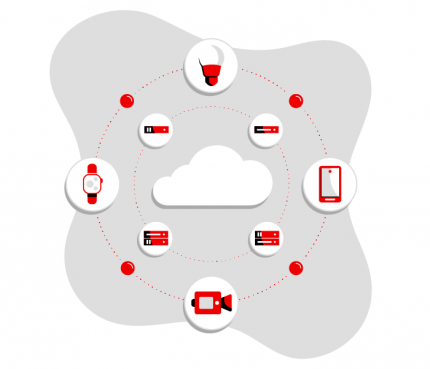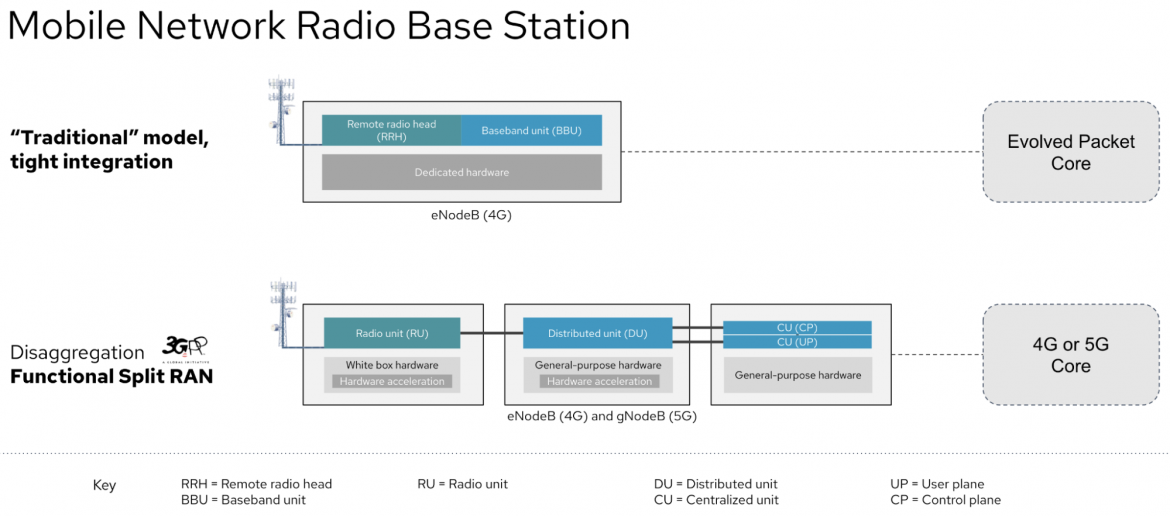红帽博客
There are many Radio Access Networks (RAN) organizations, some loosely organized (for example, industry alliances) and others more formally structured that define standards. Recent discussion has been growing about open RAN in the industry, spurred by developments, such as Rakuten building the industry’s first cloud-native infrastructure with the help of open source and open RAN.
The conversation is centering around what open RAN means: what is being done and how organizations can participate. We continue to see communications services providers (CSPs) and ecosystem players stating that open RAN and open source projects form the future foundation of the industry.

(Figure 1: RAN Evolution: two dimensions of architecture transformation)
vRAN is not necessarily an Open RAN nor O-RAN
There are many names and acronyms related to the evolution of RAN, like vRAN, open RAN, O-RAN etc. A key point to clarify is that RAN evolution means both the disaggregation of mobile network base stations into more standardized entities (this is widely known as functional split), as well as the introduction of cloud technology to enable automated deployment and scaling and to optimize the location of workloads.
Virtualized RAN is not necessarily an open RAN. Virtualized RAN simply implies the vendor has virtualized its RAN components such as baseband unit, gNB, eNodeB, distributed unit (DU) and central unit (CU) - but their components do not necessarily comply with O-RAN specifications, nor can you mix and match these components from different vendors.
The following diagrams depict the disaggregation of RAN and try to make a clear distinction between “Open” and “Virtual”. Disaggregation (functional split) is the basis, and what makes it intriguing is the fact that “open” does not have to be virtual and “virtual” does not have to be open.
The end goal is to combine both open and virtual split RAN.
(Figure 2: Disaggregation of mobile network radio base station)

(Figure 3: Open and virtual RAN models)
Some key industry activities around Open RAN model
Let’s describe now a few industry initiatives that are advancing these topics, extending beyond standards organizations like 3GPP, which of course play a major role.
O-RAN Alliance
The O-Ran Alliance, established initially by telco carriers and CSPs, is the primary organization that is defining open interfaces of split RAN architecture. It has a wide membership from the CSP and the vendor community.
Split RAN architecture was originally defined by 3GPP to address URLLC (Ultra Reliable Low Latency Communication) and eMBB (Enhanced Mobile Broadband) requirements. O-RAN is defining or clarifying the usage of the interfaces between:
-
Orchestrator and RAN components – A1 interface.
-
RIC (RAN Intelligent Controller) and CU/DU – E2 Interface.
-
CU-CP (control plane) and CU-UP (user plane) – E1 Interface.
-
CU-DU – F1 interface.
-
DU-RU (radio unit) – Open FrontHaul.
-
Orchestrator and Cloud Platform (O-Cloud) – O2 Interface.
The high level architecture of primary O-RAN logical entities, associated interfaces and their working group ownership is depicted in figure 4.

(Figure 4: O-RAN Alliance architecture)
The goal of O-RAN is to define disaggregated components in each of the working groups (WG) from WG1 to WG9. Each WG’s responsibility is as follows:
-
WG1: Use Cases and Overall Architecture Workgroup. Overall responsibility for the O-RAN Architecture and Use Cases.
-
WG2: The Non-real-time RAN Intelligent Controller and A1 Interface Workgroup. Primary goal to support non-real-time intelligent radio resource management, higher layer procedure optimization, and policy optimization in RAN and to provide AI/ML models to near-RT RIC.
-
WG3: The Near-real-time RIC and E2 Interface Workgroup. Focus to define an architecture based on Near-Real-Time Radio Intelligent Controller (RIC), which enables near-real-time control and optimization of RAN elements and resources via fine-grained data collection and actions over the E2 interface.
-
WG4: The Open FrontHaul Interfaces Workgroup. Principal objective to deliver truly open fronthaul interfaces through which multi-vendor DU-RU interoperability can be realized.
-
WG5: The Open F1/W1/E1/X2/Xn Interface Workgroup. Objective to provide fully operable multi-vendor profile specifications (which shall be compliant with 3GPP specification) for F1/W1/E1/X2/Xn interfaces and in some cases will propose 3GPP specification enhancements.
-
WG6: The Cloudification and Orchestration Workgroup. Goal to drive the decoupling of RAN software from the underlying hardware platforms and to produce technology and reference designs that would allow commodity hardware platforms to be used for all parts of a RAN deployment, including the CU and the DU.
-
WG7: The White-box Hardware Workgroup. Objective to specify and release a complete reference design to foster a decoupled software and hardware platform as a potential way to reduce the cost of 5G deployment that will benefit both the CSPs and vendors.
-
WG8: Stack Reference Design Workgroup. Primary goal to develop the software architecture, design, and release plan for the O-RAN CU and O-RAN DU based on O-RAN and 3GPP specifications for the NR (New Radio) protocol stack.
-
WG9: Open X-haul Transport Work Group. Focus on the transport domain, consisting of transport equipment, physical media and control/management protocols associated with the transport network.
-
ORAN-SC. Software committee for reference implementations with seed code donated by various companies and telcos.
Red Hat’s focus is primarily in WG6, and initially we help monitor progress in aspects relevant to clouds in WGs 4, 5, 7, 8 and 9. Most vendors are building their RAN components to these specifications and those are implied when claiming “open RAN compliant.” The correct statement would be “O-RAN Alliance compliant.”
Other Open RAN organizations
The O-RAN alliance is the only body that is clearly defining the interfaces and is responsible for standardizing RAN components. Red Hat is collaborating with industry players to propose architecture requirements and modifications.
Telecom Infra Project (TIP) OpenRAN
TIP OpenRAN was formed by the Telecom Infra Project led by Facebook, with an original goal similar to O-RAN. However, since the establishment of O-RAN, its objectives have shifted to build RAN solutions based on general purpose vendor-neutral hardware and software-defined technology.
Recent focus has been the adoption of open compute hardware. TIP has been contributing to WG8 of the O-RAN Alliance. Additionally O-RAN Alliance and TIP have organized plugfests to verify interfaces and open hardware components like those in August and September of 2020 around the world.
TIP also has projects on Crowdcell, Open Fronthaul, Transport and backhaul for RAN. Its goal is to build a solution/reference architecture with open components.
Red Hat has been working with TIP on OpenRAN and the TIP OpenCore projects. We intend to participate in the upcoming plugtests.
TIP OpenRAN does not define new open RAN interfaces or specifications but instead accelerates adoption and deployments.
Open RAN policy Coalition
The Open RAN Policy Coalition is the newest coalition for open RAN, formed when the United States State Department was seeking input to policy review the 5G technology and vendor landscape. The goal of this coalition is to “promote policies that will advance the adoption of open and interoperable solutions in RAN as a means to create innovation, spur competition and expand the supply chain for advanced wireless technologies including 5G.”
This coalition is encouraging members to build open components that are interoperable.
It believes that “there are a variety of steps that policymakers can take to facilitate a vibrant marketplace of suppliers based upon open interfaces. To that end, the coalition will promote policies that:
-
Support global development of open and interoperable wireless technologies;
-
Signal government support for open and interoperable solutions;
-
Use government procurement to support vendor diversity;
-
Fund research and development;
-
Remove barriers to 5G deployment; and
-
Avoid heavy-handed or prescriptive solutions.
Red Hat’s Open RAN Strategy
Red Hat continues to champion the open RAN architecture and model. Our strategy to extend open hybrid cloud to the edge is in line with the above organizations’ goals. Red Hat has put efforts into tuning NFVI (network functions virtualization infrastructure) platform technology, such as Red Hat OpenStack Platform, for RAN deployment specific to open RAN models. We are working with many partners and customers for trials and deployment of open RAN.
Red Hat is also focused on advancing its comprehensive enterprise Kubernetes platform Red Hat OpenShift to match the requirements of the open RAN model to enable the industry to build cloud-native network functions that can scale seamlessly across a network from core to edge.
Learn more about how Red Hat’s open approach is aligned with the telecommunication industry as it ramps up its evolution towards cloud-native architectures and containers, and how open RAN plays an integral role to give more freedom of choice - especially in 5G use cases - delivered more securely.
Want to learn more about edge computing?
 Edge computing is in use today across many industries, including telecommunications, manufacturing, transportation, and utilities. Visit our resources to see how Red Hat's bringing connectivity out to the edge.
Edge computing is in use today across many industries, including telecommunications, manufacturing, transportation, and utilities. Visit our resources to see how Red Hat's bringing connectivity out to the edge.
Want to learn more about edge computing?
 Edge computing is in use today across many industries, including telecommunications, manufacturing, transportation, and utilities. Visit our resources to see how Red Hat's bringing connectivity out to the edge.
Edge computing is in use today across many industries, including telecommunications, manufacturing, transportation, and utilities. Visit our resources to see how Red Hat's bringing connectivity out to the edge.
About the author
Timo Jokiaho is the Chief Technologist for the Global Telco Ecosystem at Red Hat. He has comprehensive experience in the areas of systems engineering, software development and hardware development in telecommunications, mobile networks, mobile devices, data communication, embedded systems, database systems and real-time operating systems.


